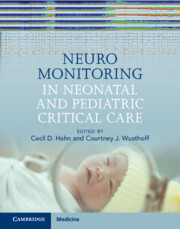Book contents
- Neuromonitoring in Neonatal and Pediatric Critical Care
- Reviews
- Neuromonitoring in Neonatal and Pediatric Critical Care
- Copyright page
- Contents
- Contributors
- Acknowledgements
- Part I General Considerations in Neuromonitoring
- Part II Practice of Neuromonitoring: Neonatal Intensive Care Unit
- Part III Practice of Neuromonitoring: Pediatric Intensive Care Unit
- Chapter 10 Management of Status Epilepticus and Recurrent Seizures
- Chapter 11 Screening for Seizures in At-Risk Pediatric Patients
- Chapter 12 Monitoring for Impending Ischemia
- Part IV Practice of Neuromonitoring: Cardiac Intensive Care Unit
- Part V Cases
- Index
- References
Chapter 11 - Screening for Seizures in At-Risk Pediatric Patients
from Part III - Practice of Neuromonitoring: Pediatric Intensive Care Unit
Published online by Cambridge University Press: 08 September 2022
- Neuromonitoring in Neonatal and Pediatric Critical Care
- Reviews
- Neuromonitoring in Neonatal and Pediatric Critical Care
- Copyright page
- Contents
- Contributors
- Acknowledgements
- Part I General Considerations in Neuromonitoring
- Part II Practice of Neuromonitoring: Neonatal Intensive Care Unit
- Part III Practice of Neuromonitoring: Pediatric Intensive Care Unit
- Chapter 10 Management of Status Epilepticus and Recurrent Seizures
- Chapter 11 Screening for Seizures in At-Risk Pediatric Patients
- Chapter 12 Monitoring for Impending Ischemia
- Part IV Practice of Neuromonitoring: Cardiac Intensive Care Unit
- Part V Cases
- Index
- References
Summary
Neurological injury is extremely common among children admitted to the intensive care unit. The importance of recognizing and treating seizures in this vulnerable pediatric population is supported by a growing body of evidence, suggesting that seizures, both clinical and subclinical, negatively impact short- and long-term clinical outcomes. Continuous EEG monitoring offers the only noninvasive means to detect subclinical seizures and to confirm whether paroxysmal events suspicious for seizures do in fact represent clinical seizure activity. This chapter will discuss the evidence to support screening for seizures in specific disease states encountered in the PICU population where clinical and subclinical seizures are common. We begin by outlining the key clinical and EEG risk factors for the development of seizures shared by children admitted to the PICU across all etiologies. We then discuss the etiology-specific risk factors. Finally, considerations related to the timing and duration of cEEG monitoring are discussed.
Keywords
- Type
- Chapter
- Information
- Neuromonitoring in Neonatal and Pediatric Critical Care , pp. 149 - 156Publisher: Cambridge University PressPrint publication year: 2022



